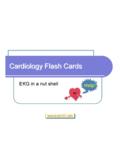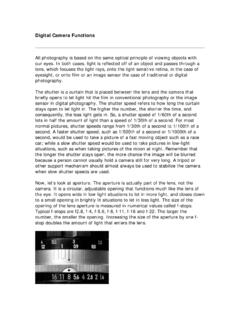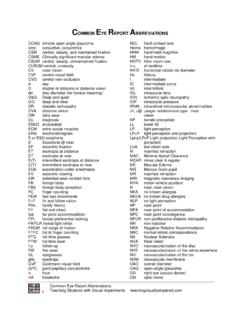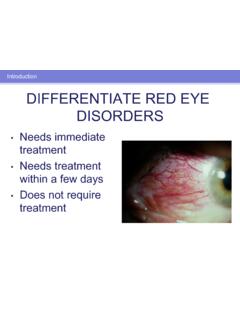Transcription of I. INTRODUCTION TO NEUROSCIENCE - Brain 101
1 1 INTRODUCTION TO NEUROSCIENCETHE NERVOUS SYSTEM (NS) CONSISTS OF Peripheral Nervous System (PNS)o Divided into Autonomic and Somatic Nervous Autonomic subdivided into Sympathetic (SNS) and Parasympathetic Nervous System (PSNS).o Somatic contains Cranial Nerves (except the Optic Nerve - CN II, which is a continuation of theBrain), and all 31 pairs of Spinal Nerves.
2 Central Nervous System (CNS)o Contains Brain and Spinal NERVOUS SYSTEM (PNS)2 -VS- SOMATIC NERVOUS SYSTEMS The autonomic system generally acts slower. The last inter-neuronal synapse of a somatic nerve is in the CNS (in the spinal column), while the lastinter-neuronal synapse of an autonomic nerve is in a peripheral AUTONOMIC NERVOUS SYSTEMC onsists of Sensory and Motor Neurons and their Axons that communicate the CNS with internal organs,muscles and reflex : Autonomic efferent fibers can be initiated in response to different types of afferentsignals: Visceral Afferent Fibers.
3 Transmission of visceral pressure, stretch, and Cell bodies of these sensory neurons are located in the sensory ganglia of CN VII, IX, and Enteroreceptors are specialized fibers to transmit these visceral signals. Somatic Afferent Fibers: Transmition of Temperature, pain, and light. Cognitive Input from higher learning centers: Perceived threats, anxiety, excitement, and sexual arousalcan all influence autonomic motor OriginCRANIO-SACRAL: CN III, VII,IX, X, and the Pelvic SplanchnicNervesTHORACO-LUMBARP reganglion Axon:Postganglionic AxonLong Preganglion Axon and shortpostganglionic Axon; Ratio isnearly 1:1, yielding discrete effectsShort Preganglionic Axon andlong postganglionic axon.
4 Ratio is1:many, yielding diffuse of Upper Cell BodiesBrainstem nuclei and sacralsegmentsIntermediolateral segments ofthe thoracolumbar spinal cordLocation of InterneuronalGangliaIn or very near the target organParavertebral and PrevertebralGanglia, far away from targetorgansPrinciple NeurotransmitterAcetylcholineNorepinephr ineOther Neurotransmitters foundVasoactive Intestinal Peptide(VIP), which results in synthesis ofNO ------> vasodilationNeuropeptide YSomatostatinEnkephalinsPrinciple NeurotransmitterReceptors at target organs:Muscarinic acetylcholinereceptors, at the end Muscarinic Autoreceptorson the postganglionic terminal,providing feedback inhibition forrelease of Ach.
5 -Adrenergic Receptors (cAMPsecondary pathway) -Adrenergic Receptors(IP3/DAG secondary pathway)Neurotransmitter InactivationAcetylcholinesterase is theprimary wayReuptake is the primary methodof getting rid of ReflexMiosis: constriction of pupil is areflex to lightAccommodation: Initiated byafferent signals from optic nerve ------> Contract ciliary muscle ------>increase natural curvature of lens ------> focus for near visionLacrimation via Facial Dilation: Radialsmooth muscle of pupil contractsCiliary Muscle RelaxationThese neurons for these reflexescome from Superior CervicalGanglion ------> Carotid PlexusDigestive ReflexSalivation via ChordaTympani (VII) andLingual (IX)
6 General increase in GI smoothmuscle toneLiver promotion of glycogenesisSalivation via sympathetics fromexternal carotid plexusGeneral Relaxation of GI smoothmuscle toneLiver induction of glycogenolysisand gluconeogenesisAnal Sphincter contractionRespiratory ReflexBronchoconstrictionVagal innervation of smoothmuscle in trachea and ReflexDecrease heart rate by vagalinnervation SA nodeIncrease heart rate by innervationof SA NodeIncrease heart contractilitySexual ReflexPenile Erection vasodilationinvolved NO and possible VIPE jaculation4 NERVOUS SYSTEM Pathway of sympathetic spinal nerves out of the spinal cord:o From spinal cord, the dorsal root and ventral root of each sympathetic nerve join to form the WhiteCommunicating The White Communicating Ramus goes to the Paravertebral Ganglia, on either side of the PREGANGLIONIC NERVE.
7 Once in the Paravertebral Chain, it can do one of four things:It Prevertebral Ganglia: The prevertebral ganglia receive preganglionics from the ThoracicSplanchnic Nerves. There are four major prevertebral ganglia: Celiac Ganglion Superior Mesenteric Ganglion Inferior Mesenteric Ganglion Aorticorenal Ganglion There are four major thoracic splanchnic nerves, which go straight through the paravertebral chainto synapse in the prevertebral ganglia. Greater Thoracic Splanchnic (T10) Lesser Thoracic Splanchnic (T11) Least Thoracic Splanchnic (T12)o POSTGANGLIONIC NERVE: For those nerves that synapse in the paravertebral chain, they can doone of two things afterwards: ADRENAL MEDULLA: Releases 80% Epi and 20% NorEpi into It is innervated by sympathetic preganglionics, which have come by way of the celiac ganglion, butthey didn t synapse It is sympathetic cholinergic, with nicotinic ganglionic acetylcholine receptors.
8 ADRENERGIC RECEPTORS:o Beta Receptors: Activated by Isoproterenolo Alpha Receptors: Activated by PhenylephrineGANGLIONIC NICOTINIC CHOLINERGIC RECEPTORS: Both sympathetic and parasympatheticneurons use acetylcholine. Their receptors are of the nicotinic type, but they are different structurally in thatthey respond differently to PLEXUS: Autonomic postganglionics are unmyelinated. Near the target organ they divide toform a meshwork-like web called a Varicosity: The autonomic axon becomes wider near the JUNCTION: The name of an autonomic synapse.
9 It is not proper to call it asynapse. It is not called a synapse because there are no ultrastructural membrane specializations between theneuron and the target cell. Thus it not a synapse. Prejunctional Element: Autonomic name for the presynapse. Postjunctional Element: Autonomic name for the Tone: The continual visceral innervation of target organs. It is the job of autonomic nerves tomodulate, either up or down, the tone of the target organ, rather than to discretely stimulate Supersensitivity: As a compensatory mechanism, a target loses autonomic innervation; itbecomes hypersensitive to said neurotransmitter.
10 Hypersensitivity due to increased synthesis of neuroreceptors. SYMPATHETIC LESIONS:o Preganglionic Lesion: Not so much hypersensitivity at Postganglion Lesion: Pronounced Hypersensitivity because there is no longer a way forneurotransmitter reuptake to occur!!FIVE WAYS TO AUTONOMICALLY REGULATE END-ORGAN ACTIVITY Antagonistic Effects on the same organ: Sympathetic and Parasympathetic have same Heart, Respiratory Passageso Urinary Bladdero Gut5 Antagonistic Effects through opposing organs.





